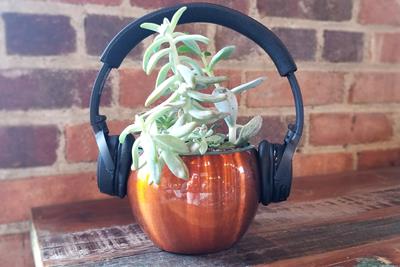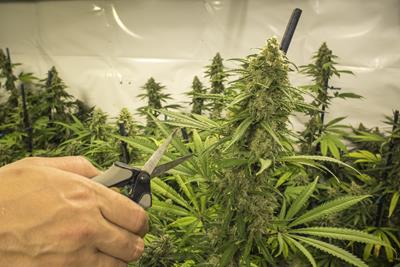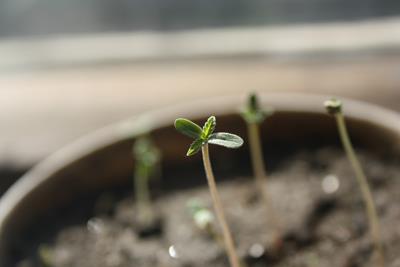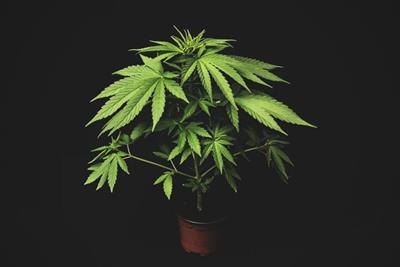
Monday March 14, 2022
By Erin Hiatt
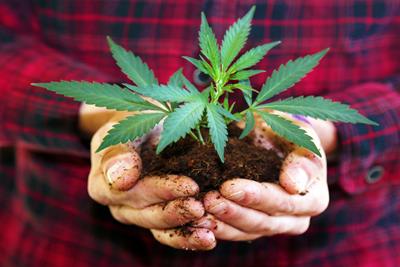 Growing
Growing
If you’re lucky enough to live in a state where it’s legal to grow your own cannabis plants, you may have considered picking up some weed clones of your favorite strain and tending your own little home grow. However, planting a weed clone in your garden is a little more labor-intensive than picking up some plants from the nursery and putting them in the ground just like you do with other plants.
There are some tips and tricks to raising a clone, so let’s dig in on how to plant your clone so it can grow into a robust, mature plant.
Supplies Needed for Raising Clones
After you’ve selected your clone, you’ll need to add some other items to the list, including clean pots with drainage holes (pros suggest one-gallon pots), new soil, and distilled water. Try to go straight home after purchasing the clone, since prolonged exposure to both hot and cold temperatures can be destructive to your plant.
Your pots should have drainage holes to make sure that the roots of your clone don’t get waterlogged. Using new pots is best, but if you are reusing containers from other plants, spray or dip them in bleach or hydrogen peroxide to remove any soil or other residue. If you do have to clean old pots, make sure they’re completely dry before beginning the transplanting process.

Soil is probably the most important ingredient in growing a healthy weed clone, so make sure the soil is new, has high nitrogen levels, and is pH 6 for best results. Fill the pot with soil, leaving about one inch of space to the top of the container. Use another pot to lightly compact the soil, but not so tightly that the roots can’t spread.
Make Sure the Clone Looks Healthy Before Planting
Before planting your clone, inspect it for fungus and pests. Look out for small specks or bite marks, white spots or fuzzy patches, yellow spots, and blistered or wet looking leaves. If any of those marks are present, quarantine the plant for up to five days to make sure it doesn’t spread to other plants. Even better, make sure you purchase from a reputable seller who will walk you through this process so you can skip it at home.
How to Plant Weed Clones
With your hands, make a hole in the soil and gently place the clone inside the hole, then use your fingers to cover the roots and fill the hole. If your clone came in Rockwool, simply make the hole big enough to accommodate the Rockwool, then cover with soil.

After you’ve transplanted them, water and mist them immediately with distilled water until water runs through the drainage holes, then lightly mist the leaves and stems.
How to Take Care of Your Clone
Now that your clone is a new home, providing it with the right temperature and amount of light are the next steps. Cannabis plants like grow rooms to be on the warmer side, so find a room that can maintain a consistent temperature between 72 and 77 degrees Fahrenheit.
Pro tip: If the room is too warm, don’t try to cool it with a fan since strongly circulating air can dry out your clone. To light your plant, use a weaker bulb, like a compact fluorescent light, and situate the plant about eight inches below the bulb. Use a timer function (or remind yourself) that your clone needs 18 hours of light and six hours of darkness in a 24-hour period.
Check the moisture level of the soil every day. It should be moist, but not saturated. It’s better to water your plant with smaller amounts of water and then adding more if needed, rather than overwatering and hoping for the best.
After six to eight weeks, clones are considered adults and can be transplanted to a larger pot following the above guidelines. Once they’ve adapted to their larger environment, you may want to consider planting them outdoors - but make sure to check your local laws on growing cannabis outdoors first.
From Clone to Garden
Moving cannabis plants from indoors to outdoors should always be done gradually since they are very sensitive to light, moisture, and humidity. Choose a day that isn’t too hot, stormy, or windy, then leave your plants in an outdoor area that won’t be disturbed by pets - or make sure your pets don’t disturb the clone due to potential unwanted “nutrients.

Find a spot that is shaded or has partial sunlight, leave the clone there until dark, then bring it back inside. Repeat this process for a week or more so the plant can adapt to its new environment. At this point, the plant should be healthy enough to move into full sunlight and into your outdoor garden. Happy growing!
Frequently Asked Questions
What Are Clones in Weed?
A clone is a cutting from a live, female cannabis plant, ensuring that the plant has its exact genetics.
How Much is a Clone of Weed?
The cost of a clone is hard to pin down because it will vary from state-to-state and by size, genetics, and rarity of strain. For an average strain in a legal state, anticipate $10-30.
Is Growing Your Own Weed Worth it?
That depends. Medical cannabis patients may benefit more from growing their own since they can ensure medicinal access and perform their own quality control. More casual consumers may find that in the long run, growing your own weed costs less, but it may simply be more convenient to buy from the local dispensary.
Is it Better to Grow From Seed or Clone?
Both methods have their pros and cons. Growing weed from seeds may be a little easier, as clones tend to be more delicate and are often harder to find. One obvious clone pro: it will have the exact genetics of the mother plant. It is impossible to tell if a cannabis seed is male or female by sight, so it’s more a game of chance when planting seeds. Feminized seeds can reduce the guessing game, but with a clone you can be certain of what you’re getting.
Have you had success raising your clones? Share what worked (and what didn’t) in the comments section!
Photo Credit: Shutterstock



